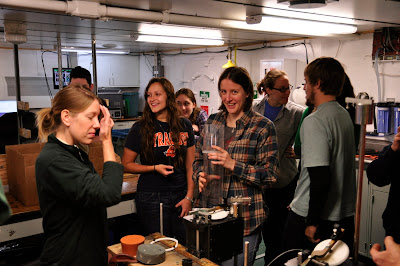Entry 4/8 - 4/15 - After finishing our seafloor and water-column studies in the
Larsen A Embayment on 8 April, we headed northward through the Prince Gustav
Channel, planning to nearly circumnavigate James Ross Island to sample
potential cold-seeps sites in in Admiralty Sound. Cold seeps are sites were methane or other energy-rich
chemical seeps from the seafloor, producing rich communities of animals related
to those found at hydrothermal vents and at whale falls. Although active cold seeps have
been photographed on the seafloor in Antarctica, no living communities of
animals have ever been sampled.
Once again, the unusually heavy sea ice in the Weddell Sea
has thwarted our sampling efforts.
We have spent the 8th through the 12th of April
backing and ramming through sea-ice composed of large, multi-year flow, some
1.5 – 2 m thick! The heavy sea-ice
blocked our path around James Ross Island to the cold seep site; after four
days backing and ramming, we turned north to avoid getting trapped in the sea
ice, which continued to thicken under the very cold conditions (- 16 C). We thus turned northward and
crunched our way northward into the Antarctic Sound. The racket caused by the
shipped ramming and crunching sea ice resounded in the galley, limiting any
conversation during meals.
The NB Palmer breaking through
a hodge-podge of new and multiyear sea ice. For scale, the ice ball next to the
ship protrudes about 3 m (10 feet) above the water.
Map of our cruise area and 36 stations.
It took us four days to break 50 miles through sea ice from Station 34
in the Prince Gustav Channel to the Station 35 in the Antarctic Sound.
We finally broke free of sea ice and entered the Antarctic
Sound in the wee hours of April 13th, planning to recover the
whale-bone lander which has been at the 1000 m deep seafloor for 2 years. The lander is designed to capture the special
animals that live on whale skeletons at the deep-sea floor, which include bone
eating worms, bristle worms that graze on bacterial mats, and a large diversity
of other invertebrates. The bone
lander could only be recovered in daylight, so we first conducted a Blake trawl, and a yoyo-camera survey
to in the Antarctic Sound, an embayment never before sampled by benthic
ecologists. The Blake trawl contained a remarkable fauna of holothurians,
sea spiders, and giant polychaete worms. The trawl reeked of sulfide and was
full of black sediment. The yoyo-camera survey revealed extraordinary
concentrations of macroalgae throughout the Sound floor, indicating substantial
horizontal nutrient subsidies from benthic habitats in euphotic
zone. The Antarctic Sound floor is a surprisingly food rich setting
compared to most communities at 1000 m.
Yoyo camera picture of the Antarctic Sound seafloor at 1000 m depths, showing
abundant seaweed (macroalgal) detritus, as well as anemones and numerous brittle
stars. The amount of macroalgal
detritus is extraordinary for 1000 m depths.
After daybreak at 800 am on the 13th, we
communicated acoustically with the whale-bone lander, commanding it to drop its
120 kg lead weight, allowing it to float to the sea surface. When we sent the release command,
the sea surface above the lander was free of sea ice for a ¼ mile radius.
However, in the half hour required for the lander to float to the sea surface,
sea-ice drifted over the site, to the lander came up under an ice floe. After three hours of smashing floes
with our intrepid icebreaking ship, we finally spied the lander under a translucent
ice flow, much to the relief of David Honig, whose dissertation depends on
recovering this lander experiment.
Within an hour, we had the bone lander on deck.
The
whale-bone lander on deck after 28 months on the seafloor. Whale ribs bones can
be seen attached the at right. The
nylon mesh bin in the aluminum frame also contains whale bones and thousands of
colonizing worms. The whale array smells like dead whale.
We then spent
24 hour picking and identifying the diversity of life living on the whale
bones, preserving animals for genetic, food-web and biodiversity analyses. The bone lander contained thousands of
dorvilleid polychaetes, amphipods and other animals attracted to whale bones,
and promises to provide exciting data for David Honig dissertation concerning
food-web structure in Antarctic ecosystems.
By the time the benthic ecology group had finished
processing the bone-lander samples late in the evening of April 14th,
we had completed our geological sampling, collecting a jumbo piston core 18-m
long just north of the Antarctic Sound. The sea ice was extremely heavy,
forcing us to head north towards
across the Drake Passage by 200 am on April 15th. The Antarctic Ice Gods would not let us
leave easily – we spend another 16 hours backing and ramming through heavy sea
ice before we finally broke into open water just southeast of King George
Island. Now we are “speeding” at
12 knots across the Drake Passage, in the first open ocean swell we have felt
for more than one month. If
the fair weather holds, we should be in Punta Arenas by late on April 19th,
to unload the ship and head homeward.












































